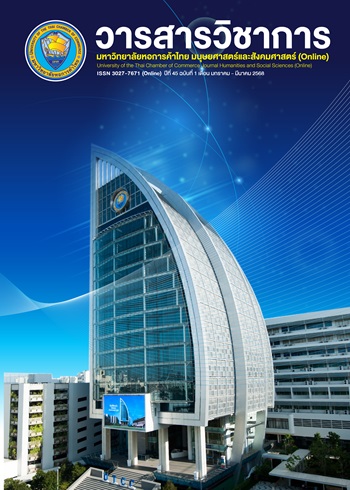Factors in Market Orientation that Affect the Competitive Advantage of SME Businesses in the Central Northeastern Region
Main Article Content
Abstract
The objective of this research was to develop and validate the causal operations of SME businesses in the Central Northeastern region and to study the factors influencing the competitive advantage that affect the operations of these businesses. The sample consisted of 400 respondents, selected using a multi-stage sampling technique. The instrument used for data collection was a questionnaire, and structural equation modeling was employed to analyze the causal relationships and identify the paths of influence among the variables, which included five components: (1) Customer Relationship Management, (2) Entrepreneurship, (3) Service Quality, (4) Market Orientation, and (5) Competitive Advantage. The results of the research showed that the causal relationship model was consistent with empirical data, as indicated by the following fit indices: Chi-square = 94.426, df = 115, p = 0.936, CMIN/DF = 0.997, GFI = 0.975, AGFI = 0.981, CFI = 1.000, RMSEA = 0.024, and SRMR = 0.012. The final predictive coefficient was 0.79. Hypothesis testing revealed that customer relationship management, entrepreneurial capability, service quality, and market orientation all had positive influences on the competitive advantage of SME businesses. Among these, entrepreneurship had the most direct influence, while service quality had the most indirect influence on creating competitive advantage through market orientation. These findings can serve as the basis for planning and developing key elements that affect the competitive advantage of SMEs.
Article Details

This work is licensed under a Creative Commons Attribution-NonCommercial-NoDerivatives 4.0 International License.
ลิขสิทธิ์ของบทความ
ผลงานที่ได้รับการตีพิมพ์ถือเป็นลิขสิทธิ์ของมหาวิทยาลัยหอการค้าไทย ห้ามมิให้นำเนื้อหา ทัศนะ หรือข้อคิดเห็นใด ๆ ของผลงานไปทำซ้ำ ดัดแปลง หรือเผยแพร่ ไม่ว่าทั้งหมดหรือบางส่วนโดยไม่ได้รับอนุญาตเป็นลายลักษณ์อักษรจากมหาวิทยาลัยหอการค้าไทยก่อน
References
Amer, R. S., & Abdulwahhab, F. L. (2020). Achieving the competitive advantage by using Customer Relationships Management (CRM). Polish Journal of Management Studies, 21(1), 61-70. https://doi.org/10.17512/pjms.2020.21.1.05
Chaudhary, S., Sangroya, D., Arrigo, E., & Cappiello, G. (2023). The impact of market orientation on small firm performance: A configurational approach. International Journal of Emerging Markets, 18(10), 4154-4169. https://doi.org/10.1108/IJOEM-03-2021-0411
Day, G. S., & Van den Bulte, C. (2002). Superiority in customer relationship management: Consequences for competitive advantage and performance (Working paper report no. 02-123). https://www.msi.org/working-papers/superiority-in-customer-relationship-
management-consequences-for-competitive-advantage-and-performance/
Deku, W. A., & Wang, J. (2022). Antecedents of market orientation and entrepreneurial marketing performance in emerging markets. IUP Journal of Entrepreneurship Development, 19(2), 22-39. https://www.proquest.com/scholarly-journals/antecedents-market-orientation-entrepreneurial/docview/2711552888/se-2 Dess, G. G., Lumpkin, G. T., & Taylor, M. L. (2005). Strategic management: Creating competitive advantage (2nd ed.). McGraw-Hill.
Elizabeth, C. (2023). The influence of market orientation, risk taking and innovative performance on new product performance: A case of Gauteng province in South Africa. African Journal of Business & Economic Research, 18(2), 205-231. https://hdl.handle.net/10520/ejc- aa_ajber_v18_n2_a10
Hoque, M. T., Ahammad, M. F., Tzokas, N, & Gabay, G. (2021). Dimensions of dynamic marketing capability and export performance. Journal of Knowledge Management, 25(5), 1219-1240. https://doi.org/10.1108/JKM-09-2019-0482
Jagodic, G., & Milfelner, B. (2022). The role of B2B marketing strategy, ICT B2B marketing support, and service quality in market orientation – performance relationship: Evidence from three European countries. Cogent Business & Management, 9(1), 1-28. https://doi.org/10.1080/23311975.2022.2128252
Jaworski, B. J., & Kohli, A. K. (1993). Market orientation: Antecedents and consequences. Journal of marketing, 57(3), 53-70. https://doi.org/10.2307/1251854
Kanjanawasee, S. (2002). Applied statistics for behavioral research (6th ed). Chulalongkorn University Press. [in Thai]
Kapur, I., Singh, A. K., & Bhardwaj, G. N. (2023). Fostering corporate entrepreneurship in SMEs: Evidence from India. Journal of Enterprising Culture, 31(1), 25-46. https://doi.org/10.1142/S0218495823500012
Karani, L. M., & Auka, D. C. (2021). Market orientation ‘Hiccups’ by service quality gaps. International Journal of Research in Commerce & Management, 12(1), 1-4.
Karnowati, N. B., & Handayani, E. (2022). Mediation role of business performance on entrepreneurship orientation and market orientation to create MSME competitiveness in pandemic times. International Journal of Research in Business & Social Science, 11(6), 138-147. https://doi.org/10.20525/ijrbs.v11i6.1980
Krejcie, R. V., & Morgan, D. W. (1970). Determining sample size for research activities. Educational and Psychological Measurement, 30(3), 608-610. https://doi.org/10.1177/001316447003000308
Lumpkin, G. T., & Dess, G. G. (2001). Linking two dimensions of entrepreneurial orientation to firm performance: The moderating role of environment and industry life cycle. Journal of business venturing, 16(5), 429-451. https://doi.org/10.1016/S0883-9026(00)00048-3
Miguel, M. D. & Crespo, C. F. (2023). The impact of the implementation of CRM strategy on consumer behavior. Polish Journal of Management Studies, 27(2), 240-259. https://doi.org/10.17512/pjms.2023.27.2.15
Octavia, A., Dewi, E., & Sriayudha, Y. (2023). The implementation entrepreneurship orientation, market orientation and business performance model for food category of micro and small entreprises. Dinasti International Journal of Digital Business Management (DIJDBM), 4(6), 1044-1052. https://doi.org/10.31933/dijdbm.v4i6.2046
Office of Small and Medium Enterprises Promotion. (2024). Statistics for the registration of entrepreneurs according to the new definition. https://www.smebigdata.com/msme/dashboard-a [in Thai]
Panrugsa, D., & Techaterapreda, S. (2024). The effect of social media participation on female millennial customer’s purchase behavior for THAI SMEs cosmetic brand. NEU Academic and Research Journal, 14(2), 187-202. https://so04.tcithaijo.org/index.php/ neuarj/article/view/270728 [in Thai]
Parasuraman, A., Zeithaml, V. A., & Berry, L. L. (1985). A conceptual model of service quality and its implications for future research. Journal of marketing, 49(4), 41-50.
Pavico, L. P. (2022). The relationship of intrapreneurship practices in the workplace and the company's competitive advantage. Journal of Algebraic Statistics, 13(3), 1022-1029. https://publishoa.com/index.php/journal/article/view/718/608
Porter, M. E. (1980). Competitive strategy: Techniques for analyzing industries and competitors. Free Press.
Tamailang, J. f., Manongko, A. Ch., Lumapow, L. S., & Wantah, E. (2021). The effect of entrepreneurship orientation and market orientation on Msmes in the culinary fields through personal excellence. Journal of Social Science, 2(6), 786-792. https://doi.org/10.46799/jss.v2i6.234
Vanichbuncha, K. (2018). SPSS for windows (31th ed). Chulalongkorn University Press. [in Thai]
Vanichbuncha, K. (2019). Structural equation analysis with AMOS (4th ed). Chulalongkorn University Press. [in Thai]
Wahyuni, N. M. & Astawa, I. P. (2020). An integrative model of market orientation on innovation performance. Journal of Management & Marketing Review (JMMR), 5(1), 51-63. https://doi.org/10.35609/jmmr.2020.5.1(5)


